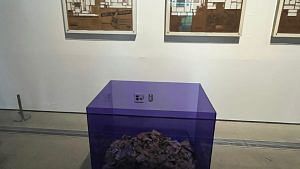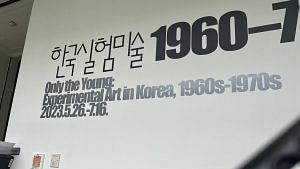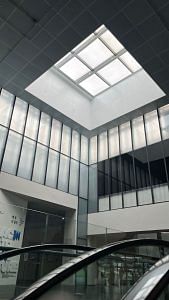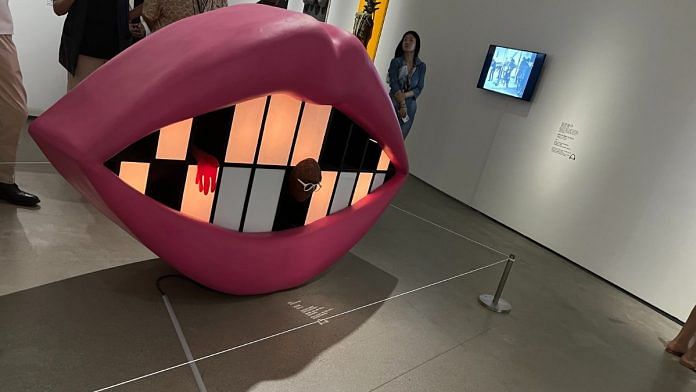Seoul: In late June, a bold, attention-grabbing installation resembling a pair of lips beckoned eager art enthusiasts to the National Museum of Modern and Contemporary Art in the South Korean capital of Seoul. This striking display was Kiss Me, a 1967 artwork by South Korean artist Jung Kangja that symbolised hidden sexual desire. Moving forward, visitors came across a cubical box with chopped bits of newspaper text—except that it was more than just scrap. Titled Newspapers: After the 1st of June 1974, this was an installation by conceptual artist Sung Neung-Kyung, who challenged the government’s media censorship during the 1970s.
Both works represent South Korea’s relatively unknown tryst with avant-garde art.
The exhibition, titled The Young: Experimental Art in Korea, 1960s-1970s, was co-organised by MMCA and New York’s Solomon R. Guggenheim Museum. It is part of the former’s big push to capitalise on the popularity of Korean pop culture and introduce the country’s high art overseas. While the world grooves to K-pop music by BTS and BLACKPINK, and enjoys K-dramas and movies such as Parasite (2019), Minari (2020) and Squid Games (2021), Korean art has limited popularity abroad. But now, MMCA wants to “expand the global interest in Korean culture to include Korean art.” In line with its ambitious attempt, the museum is also open to collaborating with Indian galleries and art houses.
“Our big mission is to introduce Korean art to the world through different international projects,” said MMCA’s director of communication, Lee Sunghee.

MMCA & India connection
India and South Korea have seldom collaborated in the field of art. However, MMCA’s acting director Park Jongdal said that the demand for stronger artistic and cultural ties was raised in 2018, when South Korea’s former First Lady Kim Jung-sook visited India. Back then, Kim, known to be a classical singer herself, had attended the annual K-pop contest organised by the Korean Cultural Centre in New Delhi as the chief guest.
And Park wants to take this forward.
“Indian people haven’t gotten a chance to know, understand and appreciate Korean art and artists and their style. And nor have Korean people gotten a chance to experience Indian art and artists. But we have felt a necessity from [the] government level, our Ministry of Culture and MMCA…we will look for more chances and opportunities to collaborate in the field of art,” said Park.
The museum’s endeavour to “build an overseas network” started last year and is still in its nascent stages. According to Lee, it was only during the Covid-19 pandemic that MMCA realised the importance of collaborating with foreign galleries. This, and the need for digitisation of artworks, curated-guide tour exhibitions and other events, are hogging all of the museum’s attention these days.
The digital museum category of MMCA’s website offers 13 categories to explore. It has also uploaded a high-resolution 30-second video of Jung’s installation of Kiss Me in this digital collection.
“We are slowly developing channels and platforms using digital technology. We have reached out through this, and we have kept and preserved the basic instinct of art appreciation,” she said.

Also read: K-pop to K-dramas, there is a new K in the life of Indians – it’s Korean language
MMCA’s international projects
The exhibition, which explored 95 artworks by 29 artists and sported 30 archival materials, opened on 26 May and wrapped up on 16 July. It will reopen at New York’s Guggenheim Museum on 1 September and shift to Los Angeles’ Hammer Museum next year. The Guggenheim website has termed it the “first North American museum exhibition dedicated to Korean experimental art (silheom misul) and its artists.”
MMCA has also secured collaborations with the National Art Museum of China and a Taiwan museum for the upcoming year. In the past year, it partnered with four overseas museums, including the Los Angeles County Museum of Art and Japan’s 21st Century Museum of Contemporary Art.
While MMCA aims to bridge physical barriers by taking Korean art to the world, it also hopes to link the real world to the metaverse. Park noted that Artificial Intelligence has seeped into the domain of contemporary art in Korea, and the museum is constantly striving to digitise and adapt to it. However, he underlined that the “old way of creating art” continues.
Also read:

State-of-the-art facilities
At the peak of Covid in May 2020, The Guardian listed MMCA among the world’s 10 best virtual museums and art galleries.
Museum officials said that its Seoul branch – consisting of 8 galleries, a movie theatre, a cafe, a library and an art shop – sees around 18 lakh visitors annually, most of whom are youth.
Established in 1969, MMCA operates four venues – in Gwacheon, Deoksugung, Seoul and Cheongju. The multipurpose museum in Seoul, which opened its doors in 2013, serves as the “face of Korean modern and contemporary” art. Its digital library and archive hold over 35,000-art related books and 88,000 archival materials, including an archive of North Korean art and key artists.
As one of Korea’s leading art and culture institutions, MMCA also runs residencies at two places – in Goyang and Changdong. Every year, the museum selects artists over the age of 25 from both South Korea and overseas and helps them organise experimental collaborations. Officials said 10 artists and one researcher from India have also participated in the residency, along with 1,000 others.
Following a fleeting monsoon shower in late June, the MMCA premises glowed with a tangible sense of purpose, reverberating with Park’s impactful words on preserving Seoul’s history and embracing modernity. This intersection of the old and the new, the past and the future, plays out in other exhibitions as well.
Apart from the Korean experimental art exhibition, the museum hosted two others. Game Society looked at how the “grammar and aesthetics of video games had influenced contemporary art,” while Back to the Future showcased a selection of artworks acquired by the museum over the last five years, offering a fresh perspective on Korean art from the recent past.
(Edited by Zoya Bhatti)



